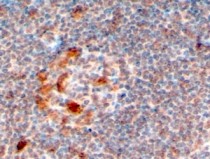ARG63142
anti-ZCCHC11 / PAPD3 antibody
anti-ZCCHC11 / PAPD3 antibody for IHC-Formalin-fixed paraffin-embedded sections and Human
Gene Regulation antibody
概述
| 产品描述 | Goat Polyclonal antibody recognizes ZCCHC11 / PAPD3 |
|---|---|
| 反应物种 | Hu |
| 预测物种 | Ms, Rat, Cow, Dog |
| 应用 | IHC-P |
| 特异性 | This antibody is expected to recognize all 3 reported isoforms (as represented by NP_001009881.1; NP_056084.1; NP_001009882.1) |
| 宿主 | Goat |
| 克隆 | Polyclonal |
| 同位型 | IgG |
| 靶点名称 | ZCCHC11 / PAPD3 |
| 抗原物种 | Human |
| 抗原 | RERCPHPPRGNVSE |
| 偶联标记 | Un-conjugated |
| 別名 | EC 2.7.7.52; Terminal uridylyltransferase 4; PAPD3; Zinc finger CCHC domain-containing protein 11; TUTase 4; TUT4 |
应用说明
| 应用建议 |
|
||||
|---|---|---|---|---|---|
| 应用说明 | IHC-P: Antigen Retrieval: Steam tissue section in Citrate buffer (pH 6.0). * The dilutions indicate recommended starting dilutions and the optimal dilutions or concentrations should be determined by the scientist. |
属性
| 形式 | Liquid |
|---|---|
| 纯化 | Purified from goat serum by antigen affinity chromatography. |
| 缓冲液 | Tris saline (pH 7.3), 0.02% Sodium azide and 0.5% BSA. |
| 抗菌剂 | 0.02% Sodium azide |
| 稳定剂 | 0.5% BSA |
| 浓度 | 0.5 mg/ml |
| 存放说明 | For continuous use, store undiluted antibody at 2-8°C for up to a week. For long-term storage, aliquot and store at -20°C or below. Storage in frost free freezers is not recommended. Avoid repeated freeze/thaw cycles. Suggest spin the vial prior to opening. The antibody solution should be gently mixed before use. |
| 注意事项 | For laboratory research only, not for drug, diagnostic or other use. |
生物信息
| 数据库连接 | |
|---|---|
| 背景介绍 | ZCCHC11 is an RNA uridyltransferase (EC 2.7.7.52) that uses UTP to add uridines to the 3-prime end of substrate RNA molecules (Jones et al., 2009 [PubMed 19701194]).[supplied by OMIM, Jan 2011] |
| 研究领域 | Gene Regulation antibody |
| 预测分子量 | 185 kDa |
检测图片 (1) Click the Picture to Zoom In






